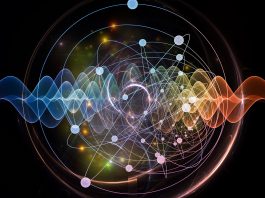Justin Evans from the University of Manchester details the UK’s significant contributions to the Deep Underground Neutrino Experiment in the US.
Designed to unlock the mysteries of neutrinos, the Deep Underground Neutrino Experiment (DUNE) is an international flagship experiment being installed in the Long-Baseline Neutrino Facility in the US. It is hoped that the experiment will paint a clearer picture of the workings of the Universe by furthering our understanding of the behaviour of neutrinos.
The U.S. Department of Energy’s Fermi National Acceleratory Laboratory (Fermilab) in Illinois will host the experiment. DUNE will consist of massive neutrino detectors, and a beam of neutrinos will be launched from Fermilab across 800 miles to its target at the Sanford Underground Research Facility.
Such a complex and technical effort requires major international collaboration, and over 1,400 scientists and engineers from across the globe are contributing to the experiment. In particular, the UK is a major partner of the experiment as it is delivering key components for the DUNE Far Detector – the anode plane assemblies (APAs). The components are being built at the Science and Technology Facilities Council’s (STFC) Daresbury Laboratory, located at Sci-Tech Daresbury in the Liverpool City Region. Physicists from the universities of Liverpool and Manchester provide the scientific leadership of the project. Due to the sheer size of the APAs and the large number required for DUNE (150), a large purpose-built APA factory was created at Daresbury inside a former accelerator hall.
To find out more about the capabilities of the APAs and the UK’s role in DUNE, Editor Georgie Purcell spoke to Justin Evans from the University of Manchester, who is heavily involved in the APA development process.
Can you start by summarising the UK’s involvement in DUNE?
The UK has significant involvement in DUNE, as we are one of the project’s biggest international partners. In the UK, we are making a number of high-profile contributions to DUNE, including the one I am most heavily involved with – the anode plane assemblies (APAs). These are the main readout devices for the detector.
I will start by briefly explaining what an anode plane is. The APAs will be installed in the first of four modules for the DUNE detector. The first module will be 17.5 kilotonnes of liquid argon located in a cryostat, one mile underground. The neutrinos coming from Fermilab hit the argon, producing charged particles such as protons, electrons, and muons. The argon is ionised as the neutrinos travel through it, knocking the electrons out of the argon atoms and leaving free electrons floating around in the argon where these particles have passed. That is what you want to obtain in order to image the neutrino reaction and visualise where the muons, pions, and protons go. We do this by putting 180,000 volts across this tank of liquid argon, which drags the negative electrons from the cathode to the anode.
The walls of this cryostat are covered with an anode plane that is 12m high and 58m long. Essentially, we want to plaster that wall with a grid of wires so that, when the electrons hit the wall, we can tell from this grid of wires which wires they hit, and that then acts like the pixels of a charge-coupled device (CCD) camera, essentially taking a photograph of the electrons inside the argon.
We are developing these readout walls, but we cannot make a wall that is 12m x 58m as the detector needs to be underground. Therefore, we are constructing 2.3m x 6m rectangular steel panels that we wrap with 3,500 wires which are 150 microns in diameter. These long wires capture the electrons. The next step is to weave those electrons out with electronics to extract the data from the detector. In total, we are building 150 of these APAs, which will eventually make up the walls that we need.
The UK is also delivering the data acquisition system – computing hardware and accompanying software that deals with the data flow out of a detector. The anode planes are producing huge amounts of electrical data and, eventually, we will record about 30 petabytes of data from the DUNE detector every year. We therefore need a system that is intelligent and only stores the data when something interesting happens, which is what the data acquisition system is for. It must monitor the detector at all times to see, for example, if a neutrino has travelled through the detector. There is an array of advanced algorithms that give the signal to trigger the detector to switch it on and store data when something interesting happens. It needs to be intelligent and only read out when something interesting is happening, but it also needs to be very efficient because you do not want to miss anything important. For example, one of the things we are trying to look for is neutrinos from supernovas, and we might only get one in the time that DUNE is switched on.
In addition, we are providing a lot of physics expertise. One particular deliverable from the UK is pattern recognition algorithms, which provide an automated data analysis method to see what happens when the neutrinos hit something. The UK has led the development of a world-leading pattern recognition software for liquid argon, Pandora.
In addition to the detector, the UK contributes to the accelerator. DUNE is the detector, and the accelerator beam coming from Fermilab is called the Long Baseline Neutrino Facility (LBNF). The UK, particularly in our national labs, has huge amounts of expertise in accelerator technology, not just detector technology. The accelerator at Fermilab is being upgraded to provide a very intense neutrino beam, by accelerating protons to high energy and smashing them against a target – a lump of graphite. The results of that collision eventually produce neutrinos. The UK is providing two things for the accelerator. The first are cavities, which accelerate the protons to high energy. The UK is also providing the graphite target that the protons hit to produce neutrinos, which is also a major piece of expertise because this lump of graphite will be hit by protons irradiated in a high radiation environment for many years, meaning it needs to be extremely robust and remain cool.
What expertise does the UK bring to DUNE?
The UK has an extensive history of world-class contributions to major particle physics experiments, particularly in the neutrino physics field. For example, many of our university groups and labs built major components of the detectors for the Large Hadron Collider (LHC), including the ATLAS, LHCb, and CMS detectors. We have also built major detector components for previous neutrino experiments in America and Japan, meaning we have a wide range of academic experts who understand the details of detector technology.
However, it is not just the academics. We have huge technical expertise in the universities and the national laboratories. We have electronics engineers, mechanical engineers, and technicians who understand what is needed to build this kind of cutting-edge technology on a large scale. We are performing bespoke engineering on a major construction scale. Building something the size of a cathedral requires a specific skillset, so having that technical expertise in the universities is a critical contribution from the UK to DUNE.
We also have a great track record in neutrino physics. Many of us working on DUNE have led analyses on previous experiments in America or Japan that have told us about how neutrinos behave. We have led some of the world’s top measurements, particularly how neutrinos behave and interact with matter. Additionally, we have a lot of expertise in liquid argon. DUNE is a liquid argon detector. It is the biggest one that will have ever been built, but it is not the first one. There were previous experiments that showed that liquid argon could work for this next-generation experiment.

For example, my other job aside from DUNE is as Co-Spokesperson for the MicroBooNE experiment, a smaller liquid argon detector. It is much smaller than DUNE, but probably the first reasonably large liquid argon time projection chamber (TPC) that ran for a long time, and it proved we could run this detector stably for more than five years and perform world-class neutrino physics with it. Many techniques and tools we will use for DUNE were invented as part of MicroBooNE, such as the Pandora pattern recognition algorithm.
What progress has been made with the APA components in 2022?
2022 has been a big year for us, as we moved into a mass production phase. We need to build 150 APAs, which will take us from now until the start of 2027. To do that, we have set up a production factory at the Daresbury laboratory that is 1,000m2 with four huge winding machines that hold the 6m x 2.3m frames and wind the 3,500 wires around them, connecting them to the electronics.
At the start of the year, we only had one of these production lines working and now all four are up and running. Throughout the year, the process has moved from commissioning the factory, learning the foibles of the machine, getting it up and running, commissioning the machine, and starting to train our staff on how to use it to the point now, where four teams are working in parallel.
Alongside the setup, we have also been hiring a team of people and training them within the factory to independently operate very bespoke machines and build particle detectors. We have created jobs in the northwest of England, where people with no previous experience in particle physics are being brought in as technicians and trained to build a particle detector.
In addition, we have been building strong relationships with suppliers. The basic structure of these APAs is comprised of steel, which we acquire from an industrial supplier near Sunderland. Also, for the full production project, we need around 40,000 electronics boards to put on the APAs, which are supplied by a company in North Wales. These are just two examples, but establishing and signing these multimillion-pound deals this year has been critical to ensuring the flow of materials to the factory for the duration of the project.
We also built a final prototype at CERN this year. We built an initial prototype back in 2018 to prove that the detector worked before we started production, but we also built a final prototype to make sure that the components we are building in the UK fit together with the parts our international partners are building, such as photon detectors and readout electronics. It has been a massive year of progress, and we feel we are now in this mass production phase.
Have you encountered any significant challenges throughout the process so far, and if so, how have these been overcome?
Yes, huge challenges. We had to set this project up during the COVID-19 pandemic, and setting up a major construction project with international partners in a pandemic is not easy. For example, the period when we were building the 1,000-square-metre factory in Daresbury was exactly when the global lockdowns were imposed, so it definitely slowed down the process. But we had to push through, keep working, and get people back into the laboratory as soon as we were allowed to.
We were also starting to establish our relationships with suppliers when lockdown started, so we could not travel to visit them, which made the process difficult. Additionally, we could not work in the same way we had been doing with international engineers at Fermilab and CERN. We therefore relied heavily on video conference meetings and getting back to work as quickly as restrictions would allow. Fortunately, the people we have are really talented and driven, going above and beyond and finding really inventive ways of making things happen. We were walking people through setups via video call, with one technician in the factory and everybody else online trying to problem-solve remotely. Because of lockdown halting progress, we also had to find ways to speed things up. We are now looking at getting a fifth winder to regain some of the time we lost during lockdown restrictions.
The other big challenge is doing this in a period of inflation, as the prices of everything drastically increased. We were given a grant from UK Research and Innovation (UKRI) just before the pandemic, so we priced up the project in 2019. However, during the pandemic, steel prices, international shipping, and general manufacturing costs increased. We therefore had to evaluate our designs as carefully as possible to find ways to reduce costs, searching globally to find the most cost-effective suppliers. Then we were trying to build something at CERN, and Brexit happened, presenting further financial and logistical challenges.
What is next for the collaboration, and what are your aims for the near future?
Internationally, the project is moving into the mass production phase. In the UK, we will be making the APAs until the start of 2027. Elsewhere, our international partners are transitioning into this mass production phase of building many other components, including photon detectors, readout electronics, and the detector structure.
We are also tackling the logistics of getting this detector underground, such as transporting the components to South Dakota exactly when it is needed to go underground because, when you are using a single mile-deep mineshaft, it is a logistical nightmare to get everything underground at the right time.
Justin Evans
Professor of Particle Physics
University of Manchester
https://lbnf-dune.fnal.gov/
Please note, this article will also appear in the twelfth edition of our quarterly publication.





